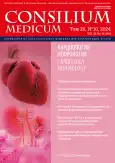The prevalence of the symptom of "hyperechoic pyramids" in children born with very low and extremely low body weight
- Authors: Mironova A.K.1, Osmanov I.M.1, Potyanova O.I.1
-
Affiliations:
- Bashlyaeva Children's City Clinical Hospital
- Issue: Vol 26, No 10 (2024): Cardiology and nephrology
- Pages: 694-697
- Section: Articles
- URL: https://bakhtiniada.ru/2075-1753/article/view/271608
- DOI: https://doi.org/10.26442/20751753.2024.10.202974
- ID: 271608
Cite item
Full Text
Abstract
Aim. To determine the frequency and factors contributing to the formation of c-ma "hyperechoic pyramids" in children born with very low and extremely low body weight, as well as to assess kidney function in this contingent of children in a three-year catamnesis.
Materials and methods. A comparative analysis of the ultrasound pattern of the urinary system was carried out in 756 premature babies, from birth to 3 years of age, two groups were identified: group I – 133 children who had hyperechoic pyramids in the neonatal period; group II – 643 children without hyperechoic pyramids in the neonatal period; group III – the comparison group – 3000 full-term neonates.
Results. The symptom of "hyperechoic pyramids" was detected in 15% of premature babies (group I) by the end of 1 month of life (25±6 days), in full-term babies (group III) – in 23 at the age of the first 3–10 days of life. In 2% of premature infants up to 2 months of age, hyperechoic inclusions were diagnosed, giving an acoustic shadow, which were interpreted as kidney concretions. It was revealed that the need (100% vs 71%) and duration (9.7 days vs 2.8 days) for mechanical ventilation, drug load and frequency of artificial feeding (92% vs 19%) in the I group were higher than in the II group. By 12 months of age, signs of nephrocalcinosis with hypercalciuria in group I were detected in 74% of patients and by 36 months were preserved in 23%. In 2% children with renal nodules detected in the first months of life, these changes up to 36 months of life and by 3 years of age, the frequency in group I was 6.6%.
Conclusion. In children born with very low and extremely low body weight, there is a high frequency of detection of "hyperechoic pyramids," which tends to decrease with the growth of the child. In some children, the changes are persistent with a risk of progression in the absence of proper observation and treatment. Among the aggravating external influences, a significant role belongs to long-term mechanical ventilation and oxygen dependence, high drug load by various groups of drugs, as well as artificial feeding in neonatal and infancy.
Full Text
##article.viewOnOriginalSite##About the authors
Alyona K. Mironova
Bashlyaeva Children's City Clinical Hospital
Author for correspondence.
Email: MironovaAK@zdrav.mos.ru
ORCID iD: 0000-0002-7864-5090
Cand. Sci. (Med.)
Russian Federation, MoscowIsmail M. Osmanov
Bashlyaeva Children's City Clinical Hospital
Email: MironovaAK@zdrav.mos.ru
ORCID iD: 0000-0003-3181-9601
D. Sci. (Med.), Prof.
Russian Federation, MoscowOlga I. Potyanova
Bashlyaeva Children's City Clinical Hospital
Email: MironovaAK@zdrav.mos.ru
ORCID iD: 0000-0002-1693-2238
Pediatrician
Russian Federation, MoscowReferences
- Fayard J, Pradat P, Lorthois S, et al. Nephrocalcinosis in very low birth weight infants: incidence, associated factors, and natural course. Pediatr Nephrol. 2022;37(12):3093-104. doi: 10.1007/s00467-021-05417-w
- Sutherland M, Ryan D, Black MJ, Kent AL. Long-term renal consequences of preterm birth. Clin Perinatol. 2014;41(3):561-73. doi: 10.1016/j.clp.2014.05.006
- Giapros V, Tsoni C, Challa A, et al. Renal function and kidney length in preterm infants with nephrocalcinosis: a longitudinal study. Pediatr Nephrol. 2011;26(10):1873-80. doi: 10.1007/s00467-011-1895-9
- Kist-van Holthe JE, van Zwieten PH, Schell-Feith EA, et al. Is nephrocalcinosis in preterm neonates harmful for long-term blood pressure and renal function? Pediatrics. 2007;119(3):468-75. doi: 10.1542/peds.2006-2639
- Gagnadoux M-F. Néphrocalcinose de l’enfant. EMC – Pédiatrie. 2004; 1:198-202 (in French).
- Mohamed GB, Ibrahiem MA, Abdel Hameed WM. Nephrocalcinosis in pre-term neonates: a study of incidence and risk factors. Saudi J Kidney Dis Transpl. 2014;25(2):326-2. doi: 10.4103/1319-2442.128524
- Huynh M, Clark R, Li J, et al. A case control analysis investigating risk factors and outcomes for nephrocalcinosis and renal calculi in neonates. J Pediatr Urol. 2017;13(4):356.e1-5.e5. doi: 10.1016/j.jpurol.2017.06.018
- Brennan S, Watson DL, Rudd DM, Kandasamy Y. Kidney growth following preterm birth: evaluation with renal parenchyma ultrasonography. Pediatr Res. 2023;93(5):1302-36. doi: 10.1038/s41390-022-01970-8
- Daneman A, Navarro OM, Somers GR, et al. Renal pyramids: focused sonography of normal and pathologic processes. Radiographics. 2010;30(5):1287-307. doi: 10.1148/rg.305095222
- Schell-Feith EA, Kist-van Holthe JE, van der Heijden AJ. Nephrocalcinosis in preterm neonates. Pediatr Nephrol. 2010;25(2):221-30. doi: 10.1007/s00467-008-0908-9
- Hemachandar R, Boopathy V. Transient renal medullary hyperechogenicity in a term neonate. BMJ Case Rep. 2015;2015. doi: 10.1136/bcr-2015-211285
- Khan SR, Kok DJ. Modulators of urinary stone formation. Front Biosci. 2004;9:1450-82. doi: 10.2741/1347.
- Rockwell GF, Morgan MJ, Braden G, Campfield TJ. Preliminary observations of urinary calcium and osteopontin excretion in premature infants, term infants and adults. Neonatology. 2008;93(4):241-5. doi: 10.1159/000111103
Supplementary files







